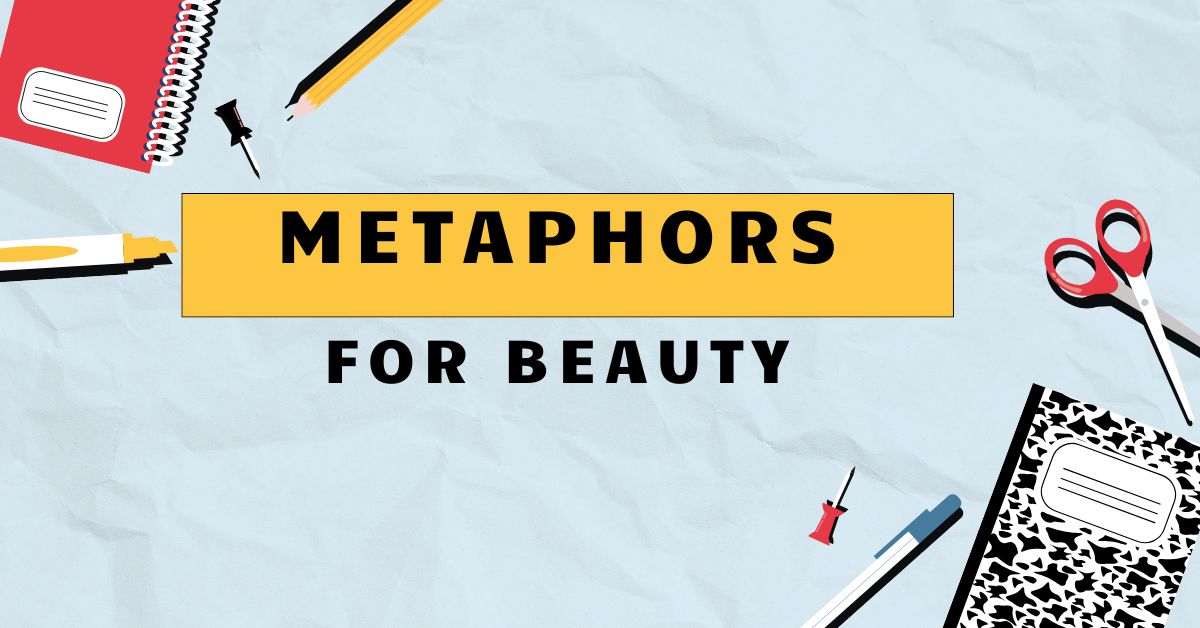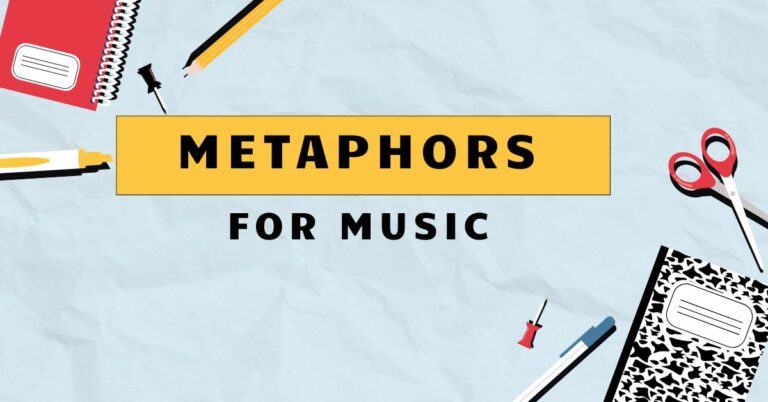41 Metaphors for Beauty: Understanding Figurative Language
Metaphors are powerful tools in the English language, allowing us to express abstract concepts in vivid and relatable ways. When used to describe beauty, metaphors elevate simple descriptions into evocative imagery, enriching both our understanding and appreciation.
This article delves into the world of metaphors for beauty, exploring their structure, types, and usage. Understanding these metaphors can enhance your writing, comprehension, and overall command of the English language.
This guide is beneficial for English language learners, writers seeking to add depth to their prose, and anyone interested in the art of figurative language.
Table of Contents
- Introduction
- Definition of Metaphor
- Structural Breakdown of Beauty Metaphors
- Types and Categories of Beauty Metaphors
- Examples of Beauty Metaphors
- Usage Rules for Beauty Metaphors
- Common Mistakes with Beauty Metaphors
- Practice Exercises
- Advanced Topics in Beauty Metaphors
- Frequently Asked Questions
- Conclusion
Definition of Metaphor
A metaphor is a figure of speech that directly compares two unrelated things without using “like” or “as.” It asserts that one thingisanother, not just that it resembles it. The primary function of a metaphor is to transfer qualities from one subject (the source) to another (the target), thereby providing new insights or perspectives.
Metaphors are essential for adding depth, color, and emotional resonance to language. In the context of describing beauty, metaphors allow us to go beyond literal descriptions and evoke a deeper, more nuanced appreciation.
Metaphors operate by creating an implicit comparison. They enrich language by allowing us to see familiar subjects in new and imaginative ways.
They are found extensively in literature, poetry, and everyday speech.
Structural Breakdown of Beauty Metaphors
Understanding the structure of a metaphor involves recognizing its key components. Thetenoris the subject being described (e.g., a person’s beauty).
Thevehicleis the object or concept used to describe the tenor (e.g., a flower). Thegroundis the shared characteristic or similarity between the tenor and the vehicle (e.g., delicate, vibrant, radiant).
Identifying these components helps to analyze and appreciate the effectiveness of a metaphor.
For example, in the metaphor “Her eyes were sparkling jewels,” the tenor is “her eyes,” the vehicle is “sparkling jewels,” and the ground is “brightness” and “attractiveness.” The vehicle lends its qualities of brilliance and preciousness to the tenor, thus enhancing the description of her eyes. The metaphor functions by implying that her eyes possess the same captivating qualities as jewels.
Types and Categories of Beauty Metaphors
Beauty metaphors can be categorized based on the source domain they draw from. Common categories include nature, light, music, art, and celestial bodies.
Each category evokes different associations and contributes a unique flavor to the description of beauty.
Nature Metaphors
Nature metaphors are among the most common and effective ways to describe beauty. They draw upon the inherent beauty and harmony found in the natural world.
Flowers, landscapes, and natural phenomena often serve as vehicles to convey qualities such as grace, vibrancy, and serenity.
Examples of nature metaphors include: “She is a blooming rose,” “Her skin was as smooth as silk,” or “His voice was a gentle breeze.” These metaphors borrow the inherent beauty of roses, silk, and breezes to elevate the subject they describe.
Light Metaphors
Light metaphors are used to convey radiance, clarity, and brilliance. They often associate beauty with sources of light such as the sun, stars, and fire.
These metaphors can create a sense of awe and wonder, emphasizing the captivating and illuminating aspects of beauty.
Examples of light metaphors include: “Her smile was a ray of sunshine,” “His eyes shone like stars,” or “She had a radiant aura.” These metaphors attribute the qualities of brightness, warmth, and brilliance to the subject’s beauty.
Music Metaphors
Music metaphors evoke a sense of harmony, rhythm, and melody. They often associate beauty with musical instruments, compositions, or sounds.
These metaphors can convey a sense of grace, elegance, and emotional depth.
Examples of music metaphors include: “Her laughter was music to my ears,” “His movements were like a graceful dance,” or “She had a melodious voice.” These metaphors borrow the qualities of harmony, rhythm, and grace from music to describe the subject.
Art Metaphors
Art metaphors draw upon the visual arts to describe beauty. They often associate beauty with paintings, sculptures, or other artistic creations.
These metaphors can convey a sense of perfection, skill, and aesthetic appeal.
Examples of art metaphors include: “She was a living masterpiece,” “His face was sculpted to perfection,” or “She was a vision of art.” These metaphors attribute the qualities of skill, perfection, and aesthetic appeal to the subject.
Celestial Metaphors
Celestial metaphors use elements of the sky and space to depict beauty. These can include the moon, stars, galaxies, and other cosmic phenomena.
These metaphors often convey a sense of wonder, vastness, and ethereal beauty.
Examples of celestial metaphors include: “Her beauty was out of this world,” “His eyes were like distant galaxies,” or “She had a lunar glow.” These metaphors borrow the qualities of vastness, wonder, and ethereal beauty from celestial elements to describe the subject.
Examples of Beauty Metaphors
The following tables provide extensive examples of beauty metaphors, categorized by type. Each table includes 20-30 examples to illustrate the range and versatility of these metaphors.
The table below showcases various nature metaphors used to describe beauty. These metaphors draw from the natural world to highlight different aspects of beauty, such as vibrancy, delicacy, and serenity.
| Category | Metaphor |
|---|---|
| Nature | Her smile was a field of sunflowers. |
| Nature | His eyes were deep, like a forest pool. |
| Nature | She was a blooming orchid in a concrete jungle. |
| Nature | Her skin was as soft as a rose petal. |
| Nature | His hair was a cascade of autumn leaves. |
| Nature | She moved with the grace of a willow tree. |
| Nature | Her voice was a gentle stream. |
| Nature | His presence was a warm, summer breeze. |
| Nature | She was a radiant sunrise. |
| Nature | Her beauty was a hidden garden. |
| Nature | He was a sturdy oak, unwavering and strong. |
| Nature | Her laughter was like the chirping of birds. |
| Nature | His spirit was as free as the wind. |
| Nature | She was a delicate snowflake, unique and beautiful. |
| Nature | His touch was as light as a butterfly’s wing. |
| Nature | She was a vibrant rainbow after the storm. |
| Nature | His words were seeds of inspiration. |
| Nature | Her heart was a fertile ground for compassion. |
| Nature | His mind was a vast ocean of knowledge. |
| Nature | She was a mountain, strong and resilient. |
| Nature | His love was a sheltering forest. |
| Nature | Her dreams were fields of wildflowers. |
| Nature | He was a calm lake reflecting the sky. |
| Nature | Her beauty was a whispering forest secret. |
The following table presents light metaphors, which emphasize the radiant and illuminating qualities of beauty. These metaphors often use light sources such as the sun, stars, and fire to convey brilliance and clarity.
| Category | Metaphor |
|---|---|
| Light | Her eyes were twin stars. |
| Light | His smile was a beacon of hope. |
| Light | She had a luminous glow. |
| Light | His presence illuminated the room. |
| Light | She was a ray of sunshine on a cloudy day. |
| Light | His words were like sparks of inspiration. |
| Light | She had a fiery spirit. |
| Light | His laughter was like a burst of fireworks. |
| Light | She was a candle in the darkness. |
| Light | His eyes shone with inner light. |
| Light | Her beauty was blinding. |
| Light | His intellect was a bright flame. |
| Light | She was a lighthouse guiding lost souls. |
| Light | His spirit was a burning ember. |
| Light | She had a radiant aura. |
| Light | His kindness was a warm glow. |
| Light | She was a flash of brilliance. |
| Light | His ideas were like lightning strikes. |
| Light | She had a sparkling personality. |
| Light | His wisdom was a guiding light. |
| Light | Her presence was like the dawn. |
| Light | His words were like a torch illuminating the path. |
| Light | She was a shining example of grace. |
This table showcases musical metaphors, which associate beauty with harmony, rhythm, and melody. These metaphors often use musical instruments, compositions, or sounds to convey grace and emotional depth.
| Category | Metaphor |
|---|---|
| Music | Her voice was a symphony. |
| Music | His laughter was a joyful melody. |
| Music | She moved with the rhythm of a song. |
| Music | His words were a harmonious chord. |
| Music | She had a lyrical quality. |
| Music | His presence was a soothing lullaby. |
| Music | She was a living ballet. |
| Music | His touch was like a gentle harp. |
| Music | She had a musical soul. |
| Music | His spirit was a vibrant concerto. |
| Music | Her beauty was an enchanting aria. |
| Music | His silence was a profound rest. |
| Music | She was a harmonious blend of talents. |
| Music | His emotions were a crescendo of passion. |
| Music | She had a captivating cadence. |
| Music | His words were a poetic verse. |
| Music | She was a graceful waltz. |
| Music | His thoughts were a complex symphony. |
| Music | She had a resonant voice. |
| Music | His actions were a well-conducted performance. |
| Music | Her presence was a calming melody. |
| Music | His words were a sweet refrain. |
| Music | She was a vibrant, jazzy tune. |
The following table includes art metaphors used to describe beauty. These metaphors often associate beauty with paintings, sculptures, or other artistic creations, conveying a sense of perfection and aesthetic appeal.
| Category | Metaphor |
|---|---|
| Art | She was a masterpiece in human form. |
| Art | His face was a sculpted work of art. |
| Art | She was a vision of classical beauty. |
| Art | His words were painted with vivid imagery. |
| Art | She had a painterly grace. |
| Art | His ideas were like brushstrokes on a canvas. |
| Art | She was a living sculpture. |
| Art | His emotions were a colorful palette. |
| Art | She had a timeless elegance. |
| Art | His presence was a grand mural. |
| Art | Her beauty was a Renaissance painting. |
| Art | His thoughts were a complex mosaic. |
| Art | She was a perfect portrait of grace. |
| Art | His actions were a carefully choreographed dance. |
| Art | She had a breathtaking composition. |
| Art | His words were a poetic collage. |
| Art | She was an artistic creation. |
| Art | His personality was a vibrant abstract painting. |
| Art | She had a captivating design. |
| Art | His work was a monumental sculpture. |
| Art | Her presence was like a priceless artifact. |
| Art | His words were like an artist’s sketch. |
| Art | She was a stunning visual display. |
This table contains celestial metaphors, which draw upon elements of the sky and space to depict beauty. These metaphors often convey a sense of wonder, vastness, and ethereal beauty.
| Category | Metaphor |
|---|---|
| Celestial | Her beauty was otherworldly. |
| Celestial | His eyes were like distant galaxies. |
| Celestial | She had a lunar glow. |
| Celestial | His presence was like a cosmic event. |
| Celestial | She was a celestial being. |
| Celestial | His thoughts were like constellations. |
| Celestial | She had a stardust shimmer. |
| Celestial | His emotions were like the tides of the moon. |
| Celestial | She had a cosmic grace. |
| Celestial | His spirit was like a supernova. |
| Celestial | Her beauty was an infinite expanse. |
| Celestial | His silence was like the vacuum of space. |
| Celestial | She was a radiant comet. |
| Celestial | His actions were like planetary movements. |
| Celestial | She had a celestial charm. |
| Celestial | His words were like shooting stars. |
| Celestial | She was a universe of beauty. |
| Celestial | His personality was like a nebula. |
| Celestial | She had a captivating orbit. |
| Celestial | His work was like a celestial map. |
| Celestial | Her presence was like a celestial alignment. |
| Celestial | His words were like a whisper from the cosmos. |
| Celestial | She was a stunning celestial display. |
Usage Rules for Beauty Metaphors
When using metaphors, it’s essential to ensure they are appropriate, effective, and clear. Here are some usage rules to keep in mind:
- Clarity: Ensure the comparison is understandable. Avoid metaphors that are too obscure or complex.
- Relevance: The vehicle should have a clear connection to the tenor. The qualities being transferred should be relevant and meaningful.
- Originality: Strive for fresh and imaginative metaphors. Overused metaphors can lose their impact.
- Consistency: Avoid mixing metaphors that create conflicting images. Maintain a consistent tone and theme.
- Context: Consider the audience and the context in which the metaphor is used. Ensure it is appropriate for the situation.
It’s also important to avoid clichés. While “Her eyes were like stars” is a common phrase, it has lost much of its impact due to overuse.
Strive to create original comparisons that bring fresh perspectives to the description of beauty.
Common Mistakes with Beauty Metaphors
Several common mistakes can undermine the effectiveness of beauty metaphors. Here are some examples of incorrect and corrected sentences:
| Incorrect | Corrected | Explanation |
|---|---|---|
| Her voice was a prickly cactus. | Her voice was a soothing balm. | The original metaphor creates a negative image, while the corrected version evokes a sense of comfort. |
| His smile was a dark cloud. | His smile was a ray of sunshine. | The original metaphor conveys negativity, while the corrected version conveys positivity and warmth. |
| She was a broken bicycle. | She was a resilient phoenix. | The original metaphor implies weakness, while the corrected version suggests strength and resilience. |
| His heart was a cold stone. | His heart was a warm hearth. | The original metaphor suggests a lack of emotion, while the corrected version conveys warmth and compassion. |
| She was a rusty nail. | She was a polished gem. | The original metaphor implies decay, while the corrected version suggests beauty and value. |
| His words were like sandpaper. | His words were like velvet. | The original metaphor conveys roughness, while the corrected version conveys smoothness and gentleness. |
| She was a tangled web. | She was a clear stream. | The original metaphor suggests confusion, while the corrected version implies clarity and purity. |
Practice Exercises
Test your understanding of beauty metaphors with these practice exercises. Each exercise includes multiple questions to help you apply the concepts learned.
Exercise 1: Identify the Metaphor
Identify the metaphor in each sentence and explain its meaning.
| Question | Answer |
|---|---|
| 1. Her laughter was a bubbling brook. | Metaphor: “Her laughter was a bubbling brook.” Meaning: Her laughter was light, joyful, and natural. |
| 2. His eyes were deep pools of wisdom. | Metaphor: “His eyes were deep pools of wisdom.” Meaning: His eyes reflected extensive knowledge and understanding. |
| 3. She was a beacon of hope in the darkness. | Metaphor: “She was a beacon of hope in the darkness.” Meaning: She provided guidance and optimism in a difficult situation. |
| 4. His words were a soothing balm to her soul. | Metaphor: “His words were a soothing balm to her soul.” Meaning: His words provided comfort and healing. |
| 5. She was a radiant star in the night sky. | Metaphor: “She was a radiant star in the night sky.” Meaning: She was brilliant, captivating, and stood out from the crowd. |
| 6. His spirit was a roaring fire. | Metaphor: “His spirit was a roaring fire.” Meaning: His spirit was passionate, intense, and full of energy. |
| 7. She was poetry in motion. | Metaphor: “She was poetry in motion.” Meaning: Her movements were graceful and beautiful like a poem. |
| 8. His touch was like a gentle breeze. | Metaphor: “His touch was like a gentle breeze.” Meaning: His touch was light, soothing, and refreshing. |
| 9. She was a living work of art. | Metaphor: “She was a living work of art.” Meaning: Her beauty was exquisite and carefully crafted. |
| 10. His presence was a warm embrace. | Metaphor: “His presence was a warm embrace.” Meaning: His presence was comforting and welcoming. |
Exercise 2: Create Your Own Metaphors
Create a metaphor to describe the following:
| Question | Answer |
|---|---|
| 1. A person’s smile | Possible Answer: Her smile was a sunrise, chasing away the darkness. |
| 2. A person’s eyes | Possible Answer: His eyes were windows to a serene and boundless soul. |
| 3. A person’s voice | Possible Answer: Her voice was a soft melody that calmed the restless sea. |
| 4. A person’s hair | Possible Answer: His hair was a cascade of molten gold. |
| 5. A person’s spirit | Possible Answer: Her spirit was an unyielding mountain, standing tall against adversity. |
| 6. A person’s laughter | Possible Answer: His laughter was a burst of summer rain, refreshing and invigorating. |
| 7. A person’s kindness | Possible Answer: Her kindness was a gentle stream nourishing a barren land. |
| 8. A person’s wisdom | Possible Answer: His wisdom was a deep ocean, full of hidden treasures. |
| 9. A person’s touch | Possible Answer: Her touch was a feather, light and comforting. |
| 10. A person’s presence | Possible Answer: His presence was a warm fire on a cold winter night. |
Exercise 3: Correct the Metaphor
Correct the following metaphors to make them more effective and appropriate:
| Question | Answer |
|---|---|
| 1. Her beauty was a rusty nail. | Corrected: Her beauty was a polished pearl. |
| 2. His smile was a stormy sea. | Corrected: His smile was a tranquil lake. |
| 3. She was a broken clock. | Corrected: She was a timeless masterpiece. |
| 4. His words were like sandpaper. | Corrected: His words were like smooth silk. |
| 5. Her presence was a dark shadow. | Corrected: Her presence was a bright light. |
| 6. His spirit was a wilted flower. | Corrected: His spirit was a blossoming garden. |
| 7. She was a tangled knot. | Corrected: She was a graceful dancer. |
| 8. His touch was like a cold stone. | Corrected: His touch was like a warm embrace. |
| 9. Her laughter was a grating noise. | Corrected: Her laughter was a melodious chime. |
| 10. His beauty was a barren desert. | Corrected: His beauty was a lush oasis. |
Advanced Topics in Beauty Metaphors
For advanced learners, exploring the nuances of extended metaphors and mixed metaphors can further enhance their understanding and usage of figurative language. Anextended metaphoris a metaphor that is sustained over several lines or even an entire piece of writing.
It allows for a more complex and nuanced comparison.
A mixed metaphor, on the other hand, combines two or more incompatible metaphors, often creating a humorous or confusing effect. While sometimes used intentionally for comedic effect, mixed metaphors are generally considered a stylistic flaw.
Another advanced topic is the use ofdead metaphors. These are metaphors that have become so common that they are no longer recognized as figurative language.
While they can be useful for conveying simple ideas, they lack the impact and originality of fresh metaphors. Recognizing and avoiding dead metaphors can help writers create more vivid and engaging prose.
Frequently Asked Questions
Here are some frequently asked questions about beauty metaphors:
- What is the difference between a metaphor and a simile?
A metaphor directly equates two things, while a simile compares them using “like” or “as.” For example, “She is a rose” (metaphor) vs. “She is like a rose” (simile). - Why are metaphors important in describing beauty?
Metaphors add depth, color, and emotional resonance to descriptions of beauty. They allow us to go beyond literal descriptions and evoke a deeper appreciation. - How can I create effective beauty metaphors?
Focus on finding relevant and meaningful connections between the subject and the object of comparison. Strive for originality and clarity. - What are some common categories of beauty metaphors?
Common categories include nature, light, music, art, and celestial bodies. Each category evokes different associations and contributes a unique flavor to the description of beauty. - What is a mixed metaphor, and why should I avoid it?
A mixed metaphor combines two or more incompatible metaphors, creating a confusing or humorous effect. While sometimes used intentionally for comedic effect, it is generally considered a stylistic flaw. - What is an extended metaphor?
An extended metaphor is a metaphor that is sustained over several lines or an entire piece of writing, allowing for a more complex and nuanced comparison. - How can I avoid using clichés when creating beauty metaphors?
Strive for originality and creativity. Think beyond common comparisons and try to find fresh and imaginative ways to describe beauty. - Can metaphors be used in everyday conversation?
Yes, metaphors are commonly used in everyday conversation to add color and expressiveness to language. - How do I identify the tenor, vehicle, and ground in a metaphor?
The tenor is the subject being described, the vehicle is the object or concept used to describe the tenor, and the ground is the shared characteristic or similarity between the tenor and the vehicle. - What are the benefits of using metaphors in writing?
Metaphors can make writing more vivid, engaging, and memorable. They can also provide new insights and perspectives.
Conclusion
Mastering the art of using metaphors for beauty can significantly enhance your ability to express yourself in English. By understanding the structure, types, and usage rules of these metaphors, you can add depth, color, and emotional resonance to your writing and speech.
Remember to strive for clarity, originality, and relevance, and avoid common mistakes such as mixed metaphors and clichés. Continued practice and exposure to diverse examples will further refine your skills and allow you to create truly captivating descriptions of beauty.
The key takeaway is that metaphors are powerful tools for conveying complex ideas and emotions in a vivid and memorable way. By incorporating them thoughtfully into your language, you can elevate your communication and connect with others on a deeper level.
Keep exploring, experimenting, and refining your skills to unlock the full potential of beauty metaphors.







